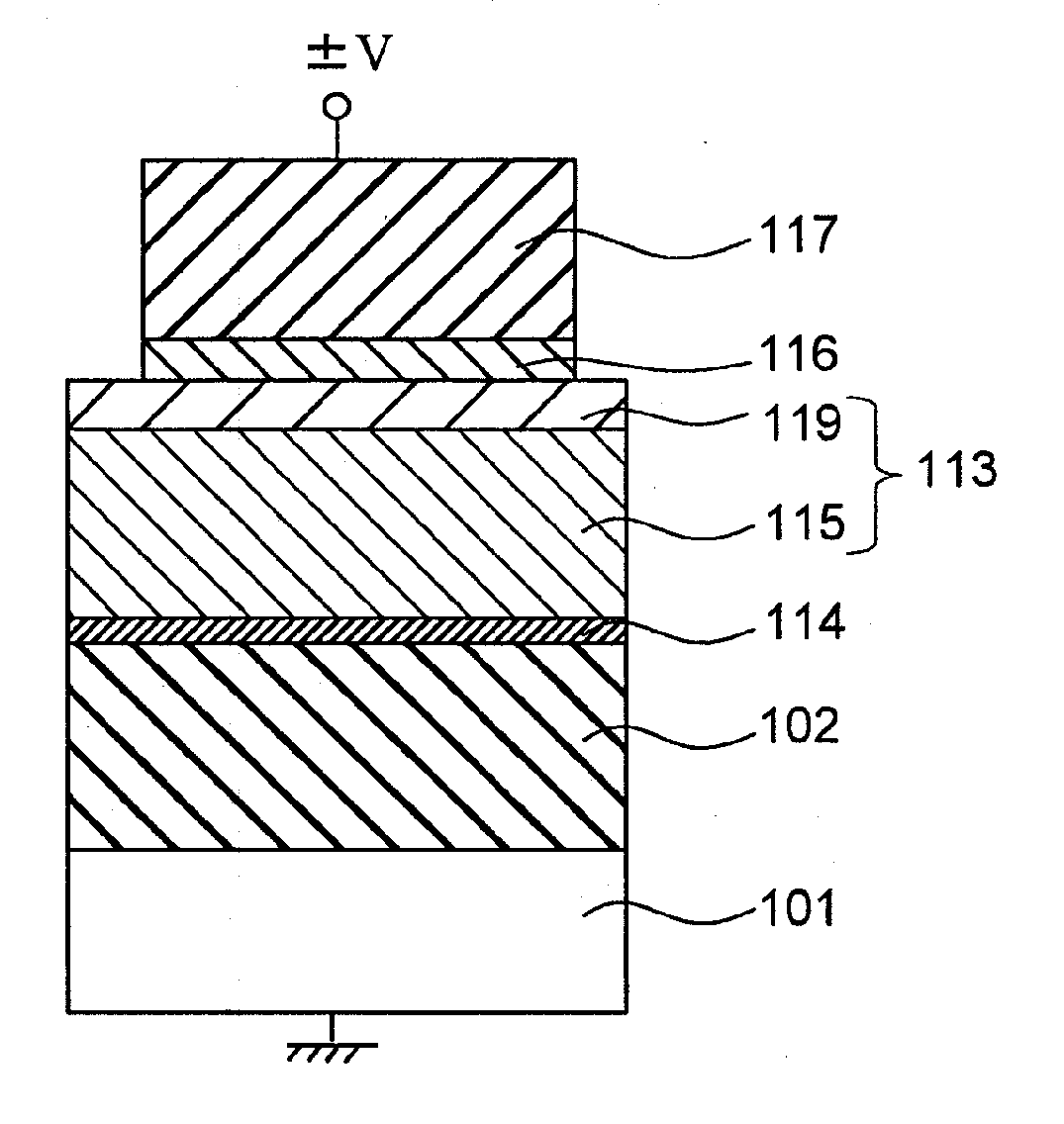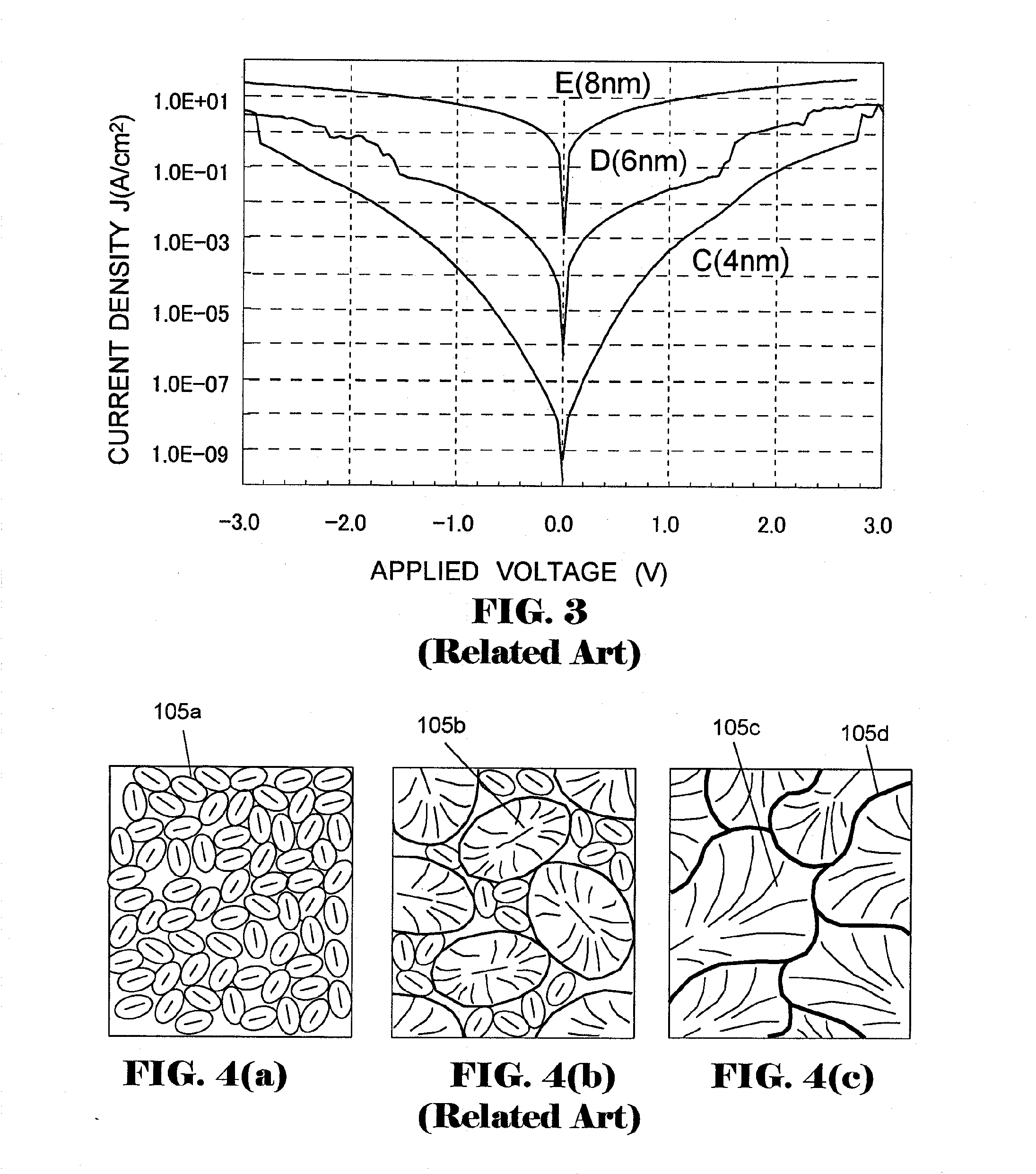Method for manufacturing semiconductor device
a manufacturing method and semiconductor technology, applied in semiconductor devices, capacitors, electrical devices, etc., can solve the problems of reducing the area on which a capacitor is formed, difficult to ensure the capacity required for a memory device, and the prospect of improving the features of a capacitor on the basis of these technical developments
- Summary
- Abstract
- Description
- Claims
- Application Information
AI Technical Summary
Benefits of technology
Problems solved by technology
Method used
Image
Examples
experiment 1
(Experiment 1)
[0057]FIG. 1 shows the structure of a flat capacitor including, on semiconductor substrate 101, which is mono-crystalline silicon, lower electrode 102 made of a titanium nitride film (TiN film), upper electrode 104 made of a TiN film in the same way, and dielectric film 103 composed of a ZrO film sandwiched between the upper and lower electrodes.
[0058]Lower electrode 102 made of a TiN film has been formed using a chemical vapor deposition (CVD) method with reaction gases of titanium tetrachloride (TiCl4) and ammonia (NH3) in consideration of the application thereof to a three-dimensional structure. The deposition temperature was 450° C., and the thickness of the film was 10 nm. Hereinafter, a TiN film formed by a CVD method is referred to as a CVD-TiN film. The CVD-TiN film is a conductor in a polycrystalline state.
[0059]The ZrO film, which is to be dielectric film 103, has been formed using an atomic layer deposition (ALD) method with a reaction gas of ozone (O3) and ...
experiment 2
(Experiment 2)
[0077]FIG. 6 illustrates a capacitor structure including, on mono-crystalline silicon semiconductor substrate 101, lower electrode 102 made of a CVD-TiN film, dielectric film 113 made of pc-ZrO film 113-c, first protective film 116 made of polycrystalline TiO (hereinafter referred to as “pc-TiO”) film 116-c, and upper electrode 117 made of a CVD-TiN film. The capacitor structure in this experiment is not three-dimensional semiconductor memory as explained above, and is constructed as a flat capacitor to achieve an easily manufacturable structure for evaluating its characteristics.
[0078]A method for manufacturing the capacitor depicted in FIG. 6 is now explained in reference to FIG. 7.
[0079]First, on semiconductor substrate 101, a CVD-TiN film, which is to be lower electrode 102, is formed by a CVD method with reaction gases of TiCl4 and NH3, as in Experiment 1, in consideration of its application to a three-dimensional structure. The film forming temperature can be 380...
experiment 3
(Experiment 3)
[0110]As explained in Experiment 2, a CVD-TiN film, which is to be upper electrode 117 in a capacitor including a ZrO film for the dielectric film, is formed at a temperature of 380° C. to 600° C. In this case, to avoid the cracks occurred with the secondary growth of crystal grains of the ZrO film, it is required to cover the surface of the dielectric film made of mc-ZrO film 113-a with first protective film 116 made of a-TiO film 116-a before forming upper electrode 117.
[0111]In this experiment, in order to improve further the leakage current characteristic, a capacitor structure in which, in addition to the aforementioned structure, a TiO film as a second protective film is formed between the lower electrode made of a TiN film and the ZrO film which is to be the dielectric film is described with reference to FIGS. 13 to 15. The capacitor according to this experiment has a stacked layer structure composed of a TiN film for upper electrode 117, a first TiO film for fi...
PUM
| Property | Measurement | Unit |
|---|---|---|
| temperature | aaaaa | aaaaa |
| temperature | aaaaa | aaaaa |
| temperature | aaaaa | aaaaa |
Abstract
Description
Claims
Application Information
 Login to View More
Login to View More - R&D
- Intellectual Property
- Life Sciences
- Materials
- Tech Scout
- Unparalleled Data Quality
- Higher Quality Content
- 60% Fewer Hallucinations
Browse by: Latest US Patents, China's latest patents, Technical Efficacy Thesaurus, Application Domain, Technology Topic, Popular Technical Reports.
© 2025 PatSnap. All rights reserved.Legal|Privacy policy|Modern Slavery Act Transparency Statement|Sitemap|About US| Contact US: help@patsnap.com



